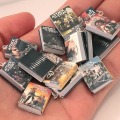There are so many super cute sea creatures! Since we love cute things at the Keybie Cafe, we’re putting together 3 sea cuties that’ll put a smile on your face. There’s a lot to learn about these adorable sea-dwellers, so we also compiled some facts to share. Some of those facts even explain their cuteness.
Let us know which one you like best in the comments!

Flapjack Octopus (Opisthoteuthis californiana/adorabilis)
Deep under the ocean’s cold, dark waters lives a species of octopus that’ll win you over with a little wiggle: the flapjack octopus! This cutie can be found along the north and northeastern Pacific and the western coast of North America.
If you’ve seen Finding Nemo, you might remember Nemo’s classmate Pearl—who happens to be a flapjack octopus herself!
This little guy grows up to 20 inches. It has flaps between its eight tentacles that give it an umbrella shape. It even has a mantle with a pair of fins that look like tiny elephant ears. The flapjack octopus swims by either pulsing its webbed arms, moving their fins, propelling water through their funnel. It can also move through all three actions at the same time. It’s not a strong swimmer, though.
When it’s not looking like parachute while floating around the water, it’s looking like an uncooked pancake while sitting on the seafloor—which it does often. Its gelatinous body looks all lumpy when spread like pancake batter.
Unlike other octopuses, the flapjack octopus can’t change colors for camouflage. Instead, it hides in plain sight to defend itself from sharks, fish, seals and sperm whales. Even though we humans can see its bright ranges of yellow to red colors against the seafloor, it’s almost invisible to its fellow deep-sea animals. This is because red wavelengths don’t penetrate the deep sea, making any red colors turn into a dark shade.
.
Sea Bunny (Jorunna parva)
Sea slugs don’t really make you think of ‘cute’ when someone brings them up, but these fluffy-looking creatures would beg to disagree. The Jorunna parva is a sea slug or nudibranch that looks like a fluffy bunny, first described by renowned malacologist (scientist who studies mollusks) Kikutaro Baba in 1934.
Its resemblance to a bunny caused it to become viral in the Japan Twittersphere in 2015, and the rest of the world got to know this unique ocean animal since. The fleshy papillae covering its body give it the appearance of being softly furred, but these are actually groups of small rods called caryophyllidia that cover the sea slug’s back.
This little sea slug’s bunny ears are rhinophores, which are scent/taste organs that help them detect chemicals in the water and make their way across the ocean floor. They can be found from the Indian Ocean, Japan, and even the Philippines!
They are incredibly small, averaging just 1cm. They’re also hermaphrodites, and are incredibly toxic. Their prey consists of sponges that also contain toxins, which are taken for the nudibranch’s own poison arsenal. Sadly, these sea bunnies only live for a couple of months to a year.
They come in a number of different colors, and are most often yellow with black specks and ‘ears’. Surprisingly, the white and black patch variety is quite rare, according to Dr. Craig R. McClain. He also reveals that they’re a hungry, hungry bunch—his work shows that nudibranchs only exist where there’s a lot of food.
Leaf Sheep (Costasiella kuroshimae)
Baa? Moo? Which ever you think this sea slug should say, one thing’s for sure—it’s darn cute. The Costasiella kuroshimae or leaf sheep is named as such because this adorable little sea slug feeds on algae.
However, what’s especially fascinating about the tiny leaf sheep is that it’s one of the very few animals that can perform photosynthesis. They suck out the chloroplasts in algae they eat and incorporate them into their own bodies. This fascinating process is called kleptoplasty.
These nudibranchs (yup, like the sea bunny) can grow up to 5mm in length. They can also be found near Japan, Indonesia and the Philippines. In fact, many divers in the Philippines call the leaf sheep Shaun the Sheep. They were first discovered in the Japanese island of Kuroshima, way back in 1993, and can be found across Asia.
They can be found in areas next to coral reefs, and spend their whole lives grazing on Avrainvillea. This is a fuzzy algae that grows in soft substrate. Avrainvillea serves as the leaf sheep’s home and source of food. When it grazes, a leaf sheep sucks out the algae’s chloroplasts, and keeps it within its cerata’s tissues through kleptoplasty. Leaf sheep can supplement their green diets with photosynthesis this way, making them “solar-powered sea slugs”.
This sea slug has black beady eyes set close together, rhinopores with black tips that look like sheep’s ears, and green appendages tipped with pink, purple or white called cerata. Also like the sea bunny, they only live between six months to a year, and are hermaphrodites.
There are so many cute and beautiful creatures in our seas
While the flapjack octopus, sea bunny and leaf sheep aren’t in critical danger, they still face threats to their survival. Climate change in particular is impacting their habitats. Intense typhoons brought about by an increasingly warmer world putting the ocean’s inhabitants at risk.
Plastic that winds up in the seas and oceans also pose as a threat. Microplastics can be ingested by any marine animal and accumulate in its system, impacting their health. To keep these critters and their marine neighbors thriving for generations to come, let’s be mindful of how we dispose of our waste.




